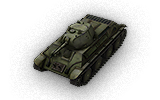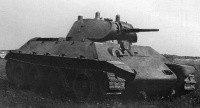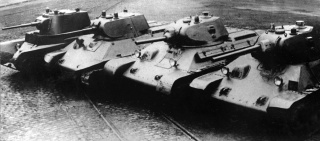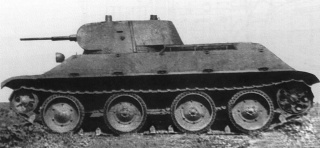A-20
A-20 (Stock)
| 134000 Coût |
| 480 PSDurabilité |
| 17.53 / 19.95 Poids |
- Chef de char
- Chargeur
- Opérateur radio
- Pilote
- Tireur
| 20/20/16Blindage caisse(avant/flancs/arrière, mm) |
| 25/25/25Blindage tourelle(avant/flancs/arrière, mm) |
| 480 chPuissance moteur |
| 65 km/hVitesse maximale / en marche arrière |
| 44 °/sVitesse de rotation |
| 55 damage |
| 51 mmPénétration moyenne |
| 3.8 Temps pour un chargement complet |
| 45 °/sVitesse de rotation du canon |
| 220 mPortée de vue |
| 500 mPortée du signal radio |

The A-20 is a very fast tank with a high top speed, but suffers from poor maneuverability at high speed. As a "scout" tank, it used to see up to tier 8 battles, but thankfully a recent patch rectified that, so it now shares the same tier spread as other tier 4 tanks.


Tourelle
| Niveau | Tourelle | Blindage tourelle (avant/flancs/arrière, mm) | Vitesse de rotation du canon (°/s) | Portée de vue (m) | Expérience | Poids (t) |
|---|---|---|---|---|---|---|
| III | A-20 mod. 1938 | 25/25/25 | 45 | 220 | 0 | 1200 |
| Niveau | Canon | Pénétration moyenne (mm) | Cadence de tir | Dispersion à 100 m | Temps de visée | Expérience | Poids (t) | |
|---|---|---|---|---|---|---|---|---|
| II | 45mm 20K | 51/88/23 | 55/55/75 | 15.79 | 0.46 | 1.9 | 0 | 250 |
| III | 37mm ZiS-19 | 58/92/19 | 40/40/50 | 20.69 | 0.35 | 1.5 | 290 | 200 |
| V | 37mm automatic SH-37 | 56/97/19 | 40/40/50 | 37.24 | 0.4 | 1.4 | 3500 | 200 |
| Niveau | Tourelle | Blindage tourelle (avant/flancs/arrière, mm) | Vitesse de rotation du canon (°/s) | Portée de vue (m) | Expérience | Poids (t) |
|---|---|---|---|---|---|---|
| IV | SP-3 | 37/37/25 | 50 | 230 | 1370 | 1300 |
| Niveau | Canon | Pénétration moyenne (mm) | Cadence de tir | Dispersion à 100 m | Temps de visée | Expérience | Poids (t) | |
|---|---|---|---|---|---|---|---|---|
| II | 45mm 20K | 51/88/23 | 55/55/75 | 16.22 | 0.46 | 1.9 | 0 | 250 |
| III | 37mm ZiS-19 | 58/92/19 | 40/40/50 | 21.05 | 0.35 | 1.5 | 290 | 200 |
| IV | 76mm L-11 | 68/75/20 | 160/160/200 | 6.32 | 0.43 | 1.8 | 510 | 660 |
| IV | 45mm VT-42 | 75/95/23 | 55/55/75 | 20 | 0.34 | 1.3 | 1280 | 322 |
| V | 37mm automatic SH-37 | 56/97/19 | 40/40/50 | 37.24 | 0.4 | 1.4 | 3500 | 200 |

Moteur
| Niveau | Moteur | Puissance moteur (ch) | Probabilité d'incendie à l'impact | Expérience | Poids (t) |
|---|---|---|---|---|---|
| V | V-2 | 480 | 15 | 0 | 750 |
| VI | V-2-34 | 500 | 15 | 5650 | 750 |

| Niveau | Suspension | Limite de charge | Vitesse de rotation (°/s) | Expérience | Poids (t) |
|---|---|---|---|---|---|
| III | A-20 mod. 1938 | 19.95 | 44 | 0 | 5000 |
| IV | A-20 mod. 1941 | 19.95 | 46 | 950 | 5000 |

Radio
| Niveau | Radio | Portée du signal radio (m) | Expérience | Poids (t) |
|---|---|---|---|---|
| IV | _9R_USSR | 500 | 0 | 80 |
Compatible Equipment
Compatible Consumables
Avis des joueurs
Points forts/faibles
Points forts :
- Above average engine power, top speed, and traverse speed.
- Good rate of fire and penetration, with better aim time and dispersion than the T-50
- Above average signal range.
- Well-sloped armor can provide some protection.
- No scout matchmaking
Points faibles :
- Below average view range.
- Poor agility at high speeds.
- Somewhat large for a light tank
Performance
On paper, the A-20 seems to be a perfectly fine Tier 4 light tank. It has a decent gun selection for Tier 4 (although the T-46 receives the same weapons one tier earlier), and it seems to have a very high top speed and good hull traverse. Unfortunately, the A-20 has issues which are not immediately obvious from just looking at the ingame statistics.
At one point of its history the A-20 received so-called "scout matchmaking". This meant that the A-20 saw up to Tier 8 battles, which was be incredibly frustrating to new players who have no experience scouting, to say the least. Thankfully, with patch 9.1, this was rectified somewhat, and now the tank sees the same sort of tier spread other tier 4 tanks share.
This isn't to say that the A-20 doesn't have its share of issues. The A-20's mobility statistics are a lie, for one. It has a tendency to bleed an incredible amount of speed on turns, and its acceleration and maneuverability are nowhere near as good as other lights. Active scouting (running about and dashing from cover to cover, spotting enemy tanks for your team) is very dangerous, and requires a lot of skill and forethought. However, the turning radius and speed are surprisingly tight, much like the BT-7. The A-20's view range is disappointingly bad for passive scouting as well. While the Pz.Kpfw. 38 (t) n.A. at least has an excellent 370 m view range, the A-20 only has a view range of 330 m. Despite the A-20's camouflage bonuses as a light tank, significant investment in the Camouflage skill is required in order to negate this weakness.
Firepower-wise, the A-20 doesn't really have much to complain about. The stock gun, the 45 mm 20K, and the 37 mm ZiS-19, which were previously used on the Tier 2 BT-2 and Tier 3 BT-7, are excellent and mediocre on those tanks, respectively. At Tier 4, they are completely useless, and should be gotten rid of as quickly as possible. There are three viable weapons. The 37 mm Automatic SH-37 is, as the name suggests, a clip-fed autocannon. It is good enough to kill lightly armoured artillery and tank destroyers and light tanks, but little else. The 45 mm VT-42 offers good accuracy, rate-of-fire, and aim time, as well as fairly good penetration (for Tier 4) in exchange for low alpha damage, making it an ideal sniper weapon. The 76 mm L-11 is the complete opposite, with terrible accuracy and aim time, low rate-of-fire, but good alpha damage. It works better at close ranges. Against Tier 4, 5, and even 6 tanks, the A-20 can still do some damage.
Unsurprisingly, since it is a light tank, the A-20 has no armor to speak of, and despite the good sloping, it should never rely on its armor to save it from enemy fire.
Modules prioritaires
- The 37 mm ZiS-19 and 12LL radio carry over from the BT-7, and should be installed immediately.
- The A-20 bis turret is absolutely necessary for the all-important increase in view range, and is also needed to mount the more advanced guns.
- Depending on playstyle, the 76 mm L-11 or 45 mm VT-42 should be researched next.
- The V-2-34 engine provides a small, but not very significant, increase in horsepower, and is also used on the T-34.
- The 37 mm Automatic SH-37 can be researched next, or may be skipped entirely if there is no intention to use it.
- Finally, the A-20 mod. 1941 suspension should be researched last. It allegedly provides a 2 d/s increase in hull traverse, but practically has no noticeable benefits to the A-20's agility.
Informations Historiques
Once it was realized that the BT tanks didn't have sufficient armor or armament, a new design was developed for a fast medium tank. In 1937, the Kharkov factory was ordered to design a new tank, and the design work started in November 1937. The chief designer was Mikhail Koshkin and his deputy, Alexsandr Morozov.
Design features The A-20 had sloping sides and a small angular turret with 25mm of armor. The tracks could be removed and could be run on just the wheels. The chassis itself was based on the BT-7M. The hull had a V-shaped glacis plate and was angled at 60°. The A-20's hull also overhung the tracks with the sides angled at 25°. In 1939, a 76.2 mm gun was installed and the vehicle was designated as the A-30. This was the same gun that was installed in the BT-7. There was an attempt to place a short barrelled 76.2 mm gun in the A-20's turret, but it just didn't work, as the turret ring couldn't absorb the recoil.
Prototype In May 1938, a wooden model of the A-20 was shown to the Defense Council of the Soviet People's Commissars (Soviet Narodnykh Komissarov, or SNAKE). Some didn't like the wheel / tracks feature carried over from the BT series, and Koshkin said it added weight that just wasn't necessary. The design had a 45 mm gun, which Koshkin said should be replaced by a 76.2 mm gun, as it was inadequate. Stalin was at this presentation and ordered that the Kharkov factory build not only a full-size prototype of the A-20, but also make the requested design changes and build a prototype that would be designated the A-30. In August 1938, the High War Council, let by the People's Commissar for Defense, K. J. Voroshilov, discussed the A-20 and T-32. Many on the Council disliked the T-32. In July 1939, the Kharkov Locomotive Factory had completed the prototypes for the A-20 and T-32. They were both then tested and it was decided to go with the T-32. On December 19, 1939, the People's Commissariat for Defense released the T-32 to the Red Army. It was soon designated the T-34.
In 1939, tests were conducted with the T-32 and A-20: the T-32 was selected as it had better fire power and armor.
Historical Gallery
Sources et Liens Externes
| Light Tanks | |
| Medium Tanks | |
| Heavy Tanks | |
| Tank Destroyers | |
| Self-Propelled Artillery |
| USA | |
| UK | |
| Germany | |
| USSR | |
| China | |
| Japan |


